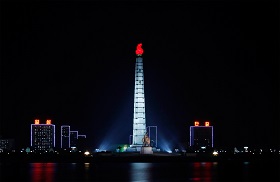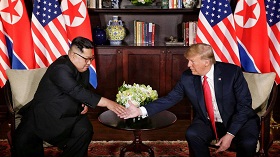The tensions that have surrounded the Korean Peninsula in recent years are among the principal threats to international security. The world once again started discussing the possibility of a nuclear war when Pyongyang violated the resolutions of the UN Security Council by holding another, sixth nuclear test and launches of intercontinental ballistic missiles in 2017, and when U.S. President Donald Trump, speaking at the UN General Assembly, responded by talking about the complete destruction of North Korea.
The problems on the Korean Peninsula have two main components. Today, the greatest emphasis is placed on North Korea’s nuclear crisis stemming from the North Korean leadership implementing their nuclear missile program in violation of the Treaty on the Non-Proliferation of Nuclear Weapons. Yet there is another component, the inter-Korean crisis, with the Korean nation being split into two separate states for over 70 years. These crises are inter-related, but their mutual influence is not straightforward. Should Pyongyang abandon its nuclear program, this action in and of itself would not put an end to the North-South confrontation. At the same time, inter-Korean normalization could give a powerful impetus to resolving the nuclear problem since North Korea’s nuclear missile program is a result of the confrontation between the two Koreas, with the U.S. siding with South Korea for over six decades.
Pyongyang’s nuclear arsenal is first and foremost intended to be a means of containment, and it is not aimed at North Korea’s southern neighbour. Were a full-scale war to break out, North Korea’s armed forces would be powerful enogh to trample the South Korean army with conventional weapons alone. However, under the 1953 Mutual Defence Treaty between the United States and the Republic of Korea, South Korea is a military ally of the United States, and the U.S. would immediately intervene in a major inter-Korean conflict. Pyongyang needs its nuclear arsenal and rocket vehicles to neutralize U.S. involvement in a potential war.
A New Aspect In Global Strategic Stability
When North Korea developed nuclear missiles, it introduced a new aspect to the issue of global strategic stability. Previously, during the Cold War, Moscow–Washington relations had been the only instrument for controlling strategic weapons. Today, the global situation has changed drastically. Regardless of whether India, Pakistan, Israel, and North Korea are recognized as new nuclear powers by the initial “nuclear five” of the Non-Proliferation Treaty, these four states are not controlled by either Washington or Moscow, or Beijing, and they will be acting independently.
North Korea is the starkest example in this regard. Pyongyang proved that even a country with limited resources, but with a determined leadership is capable of acquiring nuclear weapons if it does not intend to put up with international pressure and with possible military strikes on its territory, as was the case in Yugoslavia, Iraq, and Libya. For Pyongyang, its nuclear missile program is a security shield, and they will not part with this shield easily. North Korea’s leadership knows how the West expressed its gratitude to Libyan leader Muammar Gaddafi for voluntarily abandoning Libya’s nuclear program, and it does not wish the same fate upon itself.
Inter-Korean dialogue
A noticeable change in the situation around Korea was seen in 2018 and 2019. Three inter-Korean and two North Korea–U.S. summits were held. The thing is, however, that the parties’ declared intentions of pouring efforts into achieving stability and peace on the Korean Peninsula have not thus far translated into real action.
The Inter-Korean dialogue was advanced by two circumstances. On the one hand, having developed long-range nuclear missiles, North Korean leader Kim Jong-un seems to have decided that the chief strategic objective, i.e. ensuring North Korea’s security from the U.S., had been achieved, and the nuclear missile race could be suspended. The second reason for détente was South Korea’s behaviour. It’s not only a matter of Moon Jae-in’s initial campaign slogan of restoring dialogue with Pyongyang. Donald Trump’s aggressive 2017 rhetoric aimed at North Korea played its part, too. For the first time in several decades, the world faced the threat of a real war on the Korean Peninsula that would be started by the U.S. South Korea would be the main victim as it would take a major strike from the north. Therefore, Washington could consider the war won if North Korea were eliminated in its present state, while Seoul would envision only one kind of victory, i.e. preventing a war.
The North-South dialogue is primarily intended to lift the sanctions imposed on North Korea in connection with its nuclear dossier, restore former cooperation bridges, and build new ones. It would inevitably involve discussing the re-opening of the Kaesong Industrial Zone in North Korea close to South Korea’s border; it was a sort of a paragon of practical economic integration between North and South Korea. Its work brought inter-Korean trade turnover to USD 2.4 billion in 2014, which made South Korea North Korea’s second largest trade partner after China. The two Koreas should probably return to the question of launching joint zones like the Kaesong Industrial Zone in other North Korean regions; as an aside, this was stipulated in the arrangements achieved at the second inter-Korean summit in 2007. In 2007, regular rail services between the two Korean states across the demilitarized zone were launched, and they need to be resumed. Humanitarian ties should be given a new impetus, too, such as meetings between members of separated families, contacts between the young generation of both countries, between athletes and cultural figures; tourism needs to be developed as well.
A well-intentioned discussion of specific areas in bilateral cooperation is meant to revive the atmosphere of confidence in inter-Korean relations that was lost during the tenure of South Korea’s conservative administrations of Lee Myung-bak and Park Geun-hye. It, in turn, could serve as a foundation for talks on military political détente ultimately aimed at inter-Korean reconciliation.
The Trump – Kim dialog
Donald Trump’s turn from threatening a military strike against Pyongyang to holding a summit with Kim Jong-un was largely a forced move. Moon Jae-in’s perseverance in the cause of inter-Korean détente and the negative international sentiment concerning military actions against North Korea that threaten a nuclear war played their part. Special mention should be given, on the one hand, to the “road map” of settling the Korean Peninsula nuclear problem proposed on July 4, 2017 by the Ministries of Foreign Affairs of Russia and China. On the other hand, U.S. allies are unwilling to become involved in the U.S.’ new reckless escapades in North Korea, and that unwillingness was clearly manifested in Vancouver where a meeting was held in January 2018 between the Ministers of Foreign Affairs of the states that had participated in the 1950–1953 Korean War on the side of the South, i.e. as part of the UN forces in Korea.
North Korea appears to be genuinely interested in a détente. Pyongyang has stopped nuclear and missile tests, eliminated the Punggye-ri nuclear test site, and declared its willingness to shut down the missile range in Tongch’ang-dong and to allow foreign inspectors into the country; if “the U.S. reciprocates,” North Korea also declared it was ready to shut down its nuclear reactor in Yanbian (the principal known North Korean nuclear facility). There is no evidence that Pyongyang has transferred its nuclear technologies to third states.
In his New Year address, Kim Jong-un announced that new North Korea–U.S. relations were the principal condition for denuclearizing the Korean Peninsula. These relations should be founded on mutual trust and should be free of mutual demonization. This is not an easy task for both Pyongyang and Washington. A similar situation in China–U.S. and Vietnam–U.S. relations was eventually overcome. Future North Korea–U.S. relations could achieve the level of today’s U.S.–Vietnam interaction when the war is remembered, but memories of the past do not hinder joint work in the present. Maybe that was the thought that resulted in the decision to hold the second North Korea–U.S. summit in Hanoi.
What are Trump’s motives?
Whereas North Korea took real steps and made specific proposals concerning its dialogue with the U.S., the situation with the U.S. itself appears to be different. Many observers noted that by holding the Singapore summit with Kim Jong-un, Donald Trump primarily attempted to boost his own ratings and those of the Republican Party before the Congressional elections in November 2018. Americans are scared by North Korea’s nuclear program. And Trump would have been able to say that Barack Obama had failed to deal with the North Korean nuclear threat, while he, no matter how unpleasant the task, held a meeting and reached an agreement. No explanation would be needed to clarify the essence of the arrangements achieved. As for the Singapore summit, American voters mostly cared about the picture on their TV screens: President Trump “came, saw, and conquered”.
Trump needed the Hanoi summit with a view to the presidential campaign that is about to start in the U.S.; he is hoping to win his second term in office. Therefore, he needed to show the U.S. public specific results on the North Korean missile problem and on other pressing foreign political issues. He needed a result that neither his rivals in the Democratic Party nor his opponents in the Republican Party would be able to criticize; a result that would satisfy the U.S. Congress, American military and business circles, and such U.S. allies as Japan. But Trump failed.
Undoubtedly, arrangements achieved at summits largely determine the development of international relations, yet only provided that these arrangements result from a lengthy process of expert finalization and approval of all controversial problems.
Let’s remember how long it took to prepare the Nuclear Non-Proliferation Treaty, the Comprehensive Nuclear-Test-Ban Treaty as well as crucial Soviet-U.S. agreements on strategic stability, and how thorny the road to their signing was.
Washington was clearly not ready to conduct a detailed discussion of current problems. Donald Trump arrived at the Hanoi Summit with his old paradigms and narratives. The issue of sanctions imposed on North Korea is of crucial importance. Pyongyang had the right to expect that stopping nuclear tests and eliminating the Punggye-ri nuclear test site would result in the lifting of at least some of these sanctions. Washington, however, continued to insist on keeping all sanctions in place until North Korea’s complete nuclear disarmament.
Trump and Kim: the inequality
The unequal positions of its participants from the standpoint of their domestic and political agendas cannot but affect the current North Korea–U.S. dialogue. In 2017, the West saw North Korea’s leader as a “dwarf with a missile” who led a sanctions-besieged rogue state; at the 2018 Singapore summit, Donald Trump said he had “great respect for Chairman Kim,” and in Hanoi in 2019, he called him a “great leader”. The “young marshal”, who forced the president of the foremost imperialist power to listen to him “on equal terms” at the negotiating table, has, in the minds of his compatriots, outshone both his father and his grandfather and certainly laid a claim to the position of North Korean leader for a considerable period of time. Given Donald Trump’s confrontation with the U.S. Congress and sharp criticism Democrats and some Republicans level at virtually all his initiatives, his position looks very different, and makes many people both in the U.S. and abroad doubt his chances for re-election in 2020.
Given the situation, is Kim Jong-un interested in going all in on Donald Trump, even despite the latter’s outwardly favourable conduct toward North Korea? It is doubtful. It is in Kim’s interests to delay any specific agreements to insure himself against Donald Trump’s successor reneging on all the commitments, just like Trump today is withdrawing from the agreements concluded by his predecessors.
America’s hand is not enough
North Korea’s nuclear disarmament is too complicated a knot of problems to be cut with a single stroke dealt by America’s hand. Pyongyang needs security guarantees. It will have to take several irreversible steps such as granting access to confidential information for it to be inspected, not to mention physically dismantling its nuclear and missile infrastructure. At the same time, all the steps taken by the U.S. are easily reversible: military exercises may be resumed, sanctions re-imposed, a peace treaty denounced, and diplomatic recognition revoked. Additionally, the U.S. withdrawal from the Anti-Ballistic Missile Treaty, from the Iran nuclear deal, and from the INF Treaty has clearly demonstrated its unreliability as a partner in agreements.
Both Korean states appear to believe that settling the nuclear problem on the Korean Peninsula requires, besides the U.S., substantial participation by China and Russia, which are historically and geographically connected with Korea. This is evidenced by Kim Jong-un’s visit to China and visits to Moscow by Kim Yong-nam, President of the Presidium of the Supreme People’s Assembly of North Korea, and South Korea’s President Moon Jae-in.
Therefore, it would probably be optimal to return to the format of the six-party talks on settling the Korean Peninsula’s nuclear problem (the two Koreas, the U.S., China, Russia, and Japan) and to base these talks on a stage-by-stage approach using “action for action” principle.
Separating the nuclear program from the missile program
The discussion could be started with a proposal that North Korea’s nuclear program be separated from its missile program. North Korea’s nuclear status is enshrined in the country’s constitution, and today, this topic appears to be non-negotiable for Pyongyang. At the same time, guarantees of non-proliferation of missile and nuclear technologies and putting a freeze on its missile development program could be discussed. The exacerbation in North Korea–U.S. relations in 2017 was primarily prompted by the North Koreans developing a missile that could deliver a strike against the continental U.S. Americans are not concerned by the number of warheads North Korea has, they only care that these warheads can threaten U.S. cities.
The U.S. is mostly concerned with North Korea’s ICBMs. Pyongyang could stop developing ICBMs, could freeze production of nuclear materials, and open its nuclear facilities for international inspections; in exchange, Washington could officially recognize North Korea, establish diplomatic relations, exchange embassies, curtail military activities close to its borders, scale back and ultimately lift the sanctions, and ensure economic and energy aid to the North.
Recognizing North Korea’s statehood
The main result of the inter-Korean and North Korea–U.S. summits is that Washington and Seoul have reconciled themselves to the existence of North Korea and accepted the policy of peaceful co-existence. The pressing need today is for them to recognize North Korea as a sovereign state and recognize the legitimacy and constitutionality of its leadership. It is also important to rectify the utterly unnatural situation of the UN as a party to the Korean War still being formally at war with North Korea, one of its members. To aid South Korea during and after the Korean War, the so-called United Nations Command in Korea was established pursuant to UN Security Council Resolution 84 of July 7, 1950; the Command comprised armed forces of 16 countries led by the U.S. Since these forces participated in the Korean War under the UN flag and the 1953 Armistice Agreement was signed on their behalf, i.e. ultimately on behalf of the UN, the UN is still formally at war with North Korea. This situation is odd to say the least, since in 1991, North Korea became a full-fledged UN member.
Now is the time to adopt a UN Security Council Declaration announcing that the Korean War is a thing of the past, the UN Security Council is turning that page, and, accordingly, there is no more need for the United Nations Command in Korea. As for the U.S. forces in Korea, their presence should be regulated solely by intergovernmental agreements between South Korea and the U.S.
Peace treaty
In connection with the inter-Korean summits of 2019, the question arose several times concerning the need to replace the 1953 Korean Armistice Agreement with a peace treaty. Opinions vary widely as to what states should be party to that treaty.
The logic, however, should proceed as follows. The 1953 Armistice Agreement was not an inter-governmental document. It was signed by commanders of armed forces participating in the Korean War: Kim Il-sung, Head of North Korea’s government, Commander of China’s People’s Volunteers, and the American general, Commander-in-Chief of the UN forces. Following the instructions of Syngman Rhee, the-then President of South Korea, South Korea’s representative refused to sign the Agreement. Therefore, South Korea, the U.S., or China were not involved in the Armistice Agreement as states. Moreover, the U.S. and China did not participate in the Korean War as states. American forces fought as part of the international forces sent to Korea pursuant to the decision of the UN Security Council, and Chinese forces fought as volunteers.
Given these circumstances, the peace treaty on the Korean Peninsula should be signed by the two independent sovereign states, North Korea and South Korea, possibly with guarantees provided by the five permanent members of the UN Security Council: Russia, China, the U.S., the UK, and France.
A unique task of global significance
Settling the nuclear problem of the Korean Peninsula is a new and unique task of global significance. In this case, the problem is convincing a state that created nuclear weapons as its only security shield that it should abandon this shield in exchange for international guarantees of its independence and inviolability of its borders.
The future of Northeast Asia, the entire Asia Pacific, and global processes in general largely depends on how the situation surrounding the nuclear problem of the Korean Peninsula unfolds. This problem can only be solved collectively through the efforts of all the parties concerned.
Achieving complete confidence on the Korean Peninsula is hardly possible in the foreseeable future, but a certain degree of certainty in each other’s actions is a feasible goal. Despite the limited nature of their results, the summits in Panmunjom, Pyongyang, Singapore, and Hanoi could serve as starting points in moving toward resolving the current tasks.







